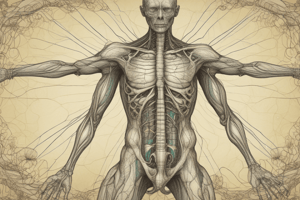Podcast
Questions and Answers
What is the function of the right lymphatic duct?
What is the function of the right lymphatic duct?
- Drains lymph from the lower limbs
- Drains lymph from the right upper extremity (correct)
- Drains lymph from the abdominal region
- Drains lymph from the left upper extremity
What is the largest lymphatic vessel?
What is the largest lymphatic vessel?
thoracic duct
How many lymphatic trunks are there?
How many lymphatic trunks are there?
five
Match the lymphatic trunks with their functions:
Match the lymphatic trunks with their functions:
What is the function of the cisterna chyli?
What is the function of the cisterna chyli?
Where are cervical lymph nodes located?
Where are cervical lymph nodes located?
What is the role of the spleen?
What is the role of the spleen?
The __________ is located in the posterior wall of the nasopharynx.
The __________ is located in the posterior wall of the nasopharynx.
What are Peyer's patches?
What are Peyer's patches?
What do lymphocytes do?
What do lymphocytes do?
Flashcards are hidden until you start studying
Study Notes
Lymphatic System Overview
- Right lymphatic duct collects lymph from the right upper extremity, head, and thorax; empties into neck veins at the junction of the right internal jugular and right subclavian veins; present in only 20% of individuals.
- Thoracic duct is the largest lymphatic vessel, draining into the left internal jugular and left subclavian veins, serving most of the body's lymphatic drainage.
Lymphatic Trunks
- Five main lymphatic trunks include:
- Lumbar trunks: drain lymph from lower limbs and pelvic region.
- Intestinal trunk: collects lymph from digestive organs like the stomach and intestines.
- Bronchomediastinal trunks: gather lymph from the thoracic viscera.
- Subclavian trunks: receive lymph from upper limbs and superior thoracic wall.
- Jugular trunks: collect lymph from the head and neck.
Lymph Nodes
- Cervical lymph nodes: located in the neck, filtering lymph from surrounding areas.
- Axillary lymph nodes: situated in the armpit, involved in immune response from upper limbs and breast tissues.
- Inguinal lymph nodes: found in the groin, filtering lymph from lower body regions.
Specialized Structures
- Cisterna chyli: a dilated sac at the thoracic duct's base, receiving lymph from the intestinal and lumbar trunks, rich in chyle (fat-rich lymph).
- Pharyngeal tonsil (adenoids): located in the posterior nasopharynx, plays a role in immune defense.
- Palatine tonsils: situated in the oral cavity, protect against pathogens entering through the pharynx.
- Lingual tonsils: located at the base of the tongue, contributing to immune function.
Key Organs
- Spleen: positioned beneath the diaphragm; functions include initiating immune responses, serving as a reservoir for blood cells, and phagocytizing old erythrocytes and pathogens.
- Thymus: a bilobed gland in the anterior mediastinum; vital for T-lymphocyte maturation; regresses with age, replaced by adipose tissue.
Lymphatic Structures
- Lymph nodes possess two main regions:
- Cortex: outer layer containing lymphatic nodules and sinuses, where T-lymphocytes are organized.
- Medulla: inner layer with medullary sinuses and cords supporting lymphatic cells.
- Germinal centers: sites within lymphatic nodules for B-lymphocyte proliferation.
- Medullary cords: connective tissue fibers supporting lymphatic cells within the medulla.
- Medullary sinuses: pathways through which lymph flows as it is filtered by lymph nodes.
Cells of the Lymphatic System
- Lymphocytes: specialized white blood cells that recognize and attack specific antigens, crucial in adaptive immunity.
Other Structures
- Vermiform appendix: a pouch extending from the large intestine, containing MALT to protect against cecal infections.
- Peyer's patches: aggregates of lymphoid tissue in the ileum, initiating immune responses to intestinal antigens.
Studying That Suits You
Use AI to generate personalized quizzes and flashcards to suit your learning preferences.




